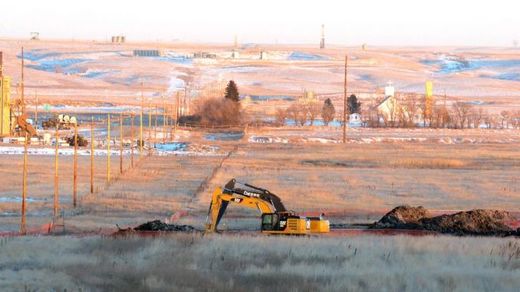
The leak, from a four-inch saltwater pipeline operated by Summit Midstream Partners LP approximately 15 miles north of Williston, occurred sometime earlier this month and was reported to state officials on Jan. 7.
It's not clear what caused the leak and an investigation is underway, a Summit spokesman said.
The leak does not pose a threat to drinking water supplies, the North Dakota Department of Health said in a statement released on Wednesday. Summit said it does not believe wildlife was affected.
The spill was first publicly reported on Jan. 8, though Wednesday's statement from the Department of Health was the first to mention the spill's volume.
It is by far the largest saltwater spill ever in North Dakota, eclipsing a leak of about 1 million gallons last July from a Crestwood Midstream Partners pipeline into Lake Sakakawea.
Saltwater is a byproduct of the hydraulic fracturing process. Typically it is filtered and re-injected back into the earth after oil is extracted, though pipelines or trucks are required to transport it to injection sites.
The saltwater from the Summit line leaked into a creek that passes by Williston, considered the capital of the state's oil boom, and flows into the Missouri River. Williston's drinking water comes from the Missouri River, though the city's water department has the ability to turn off collection valves until any harmful material washes downstream.
Summit has hired Stantec Inc clean up the spill. About 2 million gallons of water have been pulled so far from one of the affected creeks, though it was not immediately clear if that amount was all saltwater or normal water flow.
Remediation will be difficult given that much of the affected area is covered by ice.
"We will continue to work tirelessly to see that the cleanup is completed," Rene Casadaban, Summit's operating chief, said in a statement.
It's not clear when the line will re-open, though much of Summit's business involves natural gas transport, meaning day-to-day operations should not be affected too much.
The state's Department of Health said it is monitoring cleanup efforts, and the state's Department of Mineral Resources is inspecting Summit's entire pipeline network, officials said.



Comment: Despite assurances that the leak poses no danger to drinking water supplies or wildlife, the fact that the saltwater is a byproduct of fracking is a cause for concern. The numerous chemicals used in the fracking process are highly toxic, and the oil industry is not likely to 'own up' when profits are at stake.
Fracking Hell: The Untold Story